|
||||||||||||||
Vol. 18, No. 40, APRIL 3, 2006 |
||||||||||||||
The Friday Program: Operation Deep Freeze With the Polar Sea (Captain Richard A. "Mac" McCullough) | Friday Potpourri | A Mini-Assembly With International Service | Sammamish High Auction Coming | Kuechle Promotes Leadership Eastside | Corr Pearce Inducted | District Conference Update | Retreat–2006: A Leavenworth Success | Retreat Photos | Retreat Extra! Bill's Saturday Adventure | Web Fun |
||||||||||||||
The Friday Program:
McCullough, a native of Rome, Georgia, enlisted in the Coast Guard in 1966. He has served 40 years in the military, earning his commission in 1981. He has accepted many different tours of duty. At one time, he commanded the Polar Star, sister ship to the Polar Sea. He has earned the designation of Gold Ancient Mariner, which recognizes his time in service in the Coast Guard. Captain McCullough told of the 50th trip to Antarctica by a Coast Guard icebreaker, leading the way through the ice for the re-supply ships — a tanker and freighter with fuel, and a container ship loaded with a million pounds of new supplies and taking on 1.2 million pounds of recyclables for transport from McMurdo. President Lingenbrink welcomed members and guests to the final meeting of March. He introduced Hal Teel for the Invocation and Pledge, and Elena Howell, who introduced three visiting Rotarians and several guests of Rotarians. Having fulfilled the requirements of the Red Badge, Hal Teel exchanges Old Red for his new Blue Badge. Congratulations, Hal! A Mini-Assembly With International Service
“We’re the Rotarians who oversee the work of both the Rotary Foundation and the BBRC Foundation ... we get the best of both worlds ... we collect money and spend it!” Cyril introduced Don Chandler and Dick Brown, who gave a thumbnail on the Rotary Foundation Committee this year. Chandler said, “Our campaign is going quite well, with $23,000 pledged or collected by our members, which is $293 per member. We’re shooting for an average of $300 per member and a goal of $33,000. There is still one-third of the club having not yet committed to the campaign. What we want most is 'Every Rotarian participate Every Year.' If everyone participates to his/her level, we’ll be on track.” The Rotary Foundation is the organization that appropriates funds to support several of our club’s projects. As Dick Brown said, “You can pay quarterly or in a lump sum ... make it as convenient as you can. But, we’re counting on all our members participating in this campaign, which ends June 30. Make your checks out to The Rotary Foundation and give your checks to Don or me.”
World Community Service is perhaps one of the BBRC’s largest and most active committees. Curt Cummings is the chair of WCS. “It’s a big committee,” he said. “We’re helping to sponsor John Martinka and his Computers for the World trip to Slovakia (a team of 15 people leaves this week for Eastern Europe). Our $20,550 budget handles tons of requests, but our awesome committee is able to stretch our dollars and help out where we can.”
Corr’s classification is “Business Development.” He is a retired officer from active duty in the Coast Guard, having just returned from duty in Kuwait. He maintains his service in the Coast Guard reserve. Corr's business is located in Issaquah, where he lives with his two daughters. Corr is a University of Alaska and Washburn University graduate. Mention of the Topeka, Kansas, school brought a cheer from the one person who knew the name of their mascot — the Ichabods. (Sounds like something Wally Mahoney might know!) President Steve performed the induction ceremony, telling Corr he’s joined a worldwide organization that is active in 167 countries, has 1.2 million members, 33,000 clubs and his own personal 4-way Test Card. With his team of advisors, Corr will surely jump right into Rotary. The audience thought so, with a big Standing O! The deadline for the Rotarian discount on hotel rooms at Chateau Whistler has been extended until March 31st. After this date, rates will go up, and hotel rooms will no longer be exclusively reserved for our District Conference. Below are links for forms and information pertaining to this year's District Conference (all PDF):
A Saturday Shocker! Salvatori Resigns!
• • • Retreat–2006: A Leavenworth Success
Zidar highlighted his goals for the coming year. “Major areas of focus will be service, fellowship and fun. We will work hard to define what our club mission, vision and values shall be. We will work to implement a focused process of club giving. We will work to grow our membership by a net of 5 new members. We’ll expand our diversity, work on retention of our current membership, we will plan, listen and engage.” The Club Leadership Plan
• • • Mission/Vision/Values in the Midst of Change Tom opened his remarks saying, ”There will be no raffle this coming year.” The Board of Directors, taking the recommendations of a committee formed to explore changes, voted to move away from the raffle and build a new fundraising base leaning on three distinct prongs. These will be discussed in detail at the breakout sessions.” What we will be asking ourselves is what sources will we tap for fundraising? What shall our spending priorities be? How will we craft our budget and what projects will be tackle? All of these are a question of priorities in determining our vision for our club. “It’s been said that your values are how you spend your time and how you spend your money. If that’s so, we have many ways to decide what our priorities are.” At the RI level, there are scholarships (Ambassadorial Scholarships, perhaps the finest offered in the world). There is Polio Eradication, Humanitarian projects and community projects. At the club level, we’ve established ourselves as bestowers of scholarships, participating in international projects, making major BBRC Foundation grants, supporting Rotary First Harvest, sponsoring community projects and actively protecting our environment. “People think we’re the Raffle people. We’re not check-writers, we’re a hands-on service club. We’re the best darn Rotary club in the world! But, who are we, really?” The elements of change include defining our mission — what we do and how we do it. We must corral our vision — the image of ourselves and others. The process we use will result in prioritization and definition, an expression of our values. With that, the members were released to go to their respective breakout sessions. There were three sessions, governed by a color-code directing each member where they were expected to be based on the set schedule. Cary Kopczynski facilitated the session Fundraising; Jane Kuechle did Giving; Shelley Noble hanlded Projects and Membership. • • • Fundraising in the New Environment — Breakout For the coming year, the Board of Directors has decided to stage three major fundraising events. The Golf Outing, chaired by Dick Brown; a Walk-a-Thon, chaired by Jenny Andrews; and an auction, chaired by Bob McKorkle. Since planning for the Golf Outing is already underway, the discussion centered on the other two events. Jenny talked about the Walk-a-Thon, explaining there “are different ways to go in sponsoring an event like this. There are models out there than can give us direction. Our Rotary friends at Mercer Island sponsor one of the most successful such events anywhere. We see this event being staged at a place like Marymoor Park, with perhaps a picnic on the agenda. Bob McKorkle floated up the idea of a “Lifestyle Auction, one that uses assets that we have but we’re not using. For instance, a condo or cabin for a weekend that could be auctioned off. We should invite others to participate, not only to bid on items, but to provide their lifestyle items for auction. It all goes to a good cause. We’ve determined our theme must be to have fun and to incorporate new ideas.” • • • Giving, Focus/Planning — Breakout The members thought we should give where our funds will have an enduring impact, that may change people’s lives, with an emphasis on youth, using leverage available through Rotary International, but not to forget our commitment to hands-on projects. The replies came back that “we’re serving the community, we promote goodwill and understanding, we leave the world better off, we bring fellowship to the community, we are results-oriented. After all of the ideas were captured on the charts, Jane distributed colored dots, asking each participant to place six dots on the six statements that turned them on most. • • • Projects and Membership — Breakout Participants were particularly interested in serving youth with scholarships and mentorships. We should enable these to happen. “Our project world should embrace ALL of the ideas out members may have ... in other words, follow passions, make opportunities, enable these to happen.” It was pointed out that our membership is diverse financially, and those hands-on projects are important for their involvement. We should acknowledge all members' service and possibilities they bring to the club. DECA, J-A and other organizations give us the chance to partner with youth organizations for community projects. We should be on the lookout for the opportunity to establish a Rotaract club in an area high school. We should call Patti Payne with good news about Rotary’s impact in the community. • • • Fundraising Recap Questions posed:
Walkathons are popular and we should be able to tap into those who are quite familiar with staging walkathons. Mercer Island reportedly raised $150,000 for their Half-Marathon. We want to increase membership participation in all our fundraising activities. Auction – Tim Leahy has volunteered his services. • • • Where Should Our Dollars Go Recap
• • • Projects and the Membership Recap There’s a need for balance in projects ... low budget, hands-on, need for variety. Continue to support our passions – enable members who have special passions. Membership – Partnership with Sammamish parents – recruiting Retention: why do we stay in Rotary and the BBRC? It’s because of shared values. Together we really do make a difference and focus on having fun. • • • Wrap-Up to Adjourn Feedback that has been received during the Retreat indicates generally positive remarks. Attendees particularly liked Leavenworth and the Enzian — the meeting facility. It appears that the quality of comments from participants increased in intensity from years past. This could be because of the changes that have been proposed and the willingness of people to stretch and consider other avenues. Jim concluded, “We really got into it!” With the clock reading 11:35AM, adjournment was declared and a successful Retreat came to an end. The homeward trip included some snow flurries over Stevens Pass and a wet roadway. • • • The Day (and Night) Before Once the Olympic-like efforts were completed, the entire throng descended on Leavenworth’s King Ludwig’s Biergarten for a delightful buffet meal and refreshments. A highlight, beyond the award ceremony for our sporting teams, was Bob Ottos Polka Pals, who are receiving four apostrophes for their music stands, courtesy of the CPA’s in the BBRC.
The Year of the Chicken Dance After the dinner event, the serious card players retired to the Enzian for a few games of chance. Word has it that Sadru Kabani earned gas money back to Bellevue. Attendees Additionally, there were 26 partners who accompanied their Rotary members. *New members since last Planning Retreat The Friday Program:
McCullough, a native of Rome, Georgia, enlisted in the Coast Guard in 1966. He has served 40 years in the military, earning his commission in 1981. He has accepted many different tours of duty. At one time, he commanded the Polar Star, sister ship to the Polar Sea. He has earned the designation of Gold Ancient Mariner, which recognizes his time in service in the Coast Guard. Captain McCullough told of the 50th trip to Antarctica by a Coast Guard icebreaker, leading the way through the ice for the re-supply ships — a tanker and freighter with fuel, and a container ship loaded with a million pounds of new supplies and taking on 1.2 million pounds of recyclables for transport from McMurdo.
What made this trip so tough was the condition of the ice. “We had 84 miles of 8-foot ice to ram through in order to reach our destination. It was the worst ice year in history.” McMurdo Station is located on Ross Island, and is the largest outpost on the continent. The build-up of ice on the Ross Ice Shelf spawns ice bergs. A “berg” numbered 15A is 1200 square miles, the size of Rhode Island and actually blocked access to McMurdo in 2003-2004. The iceberg was so huge it created its own weather system. The Polar Sea is a non-nuclear ship with a sledgehammer bow. It does great in solid water, according to Captain McCullough. Some of the ice chunks the ship plows through are the size of school buses. The ship must move back and forth in order to ram the ice. The broken ice path must be groomed to allow passage of the supply ships. McMurdo’s weather in summer is 28-38 degrees air temperature. It gets easily 100 below in the winter. With 1200 personnel at the Station in summer, they have a semblance of comforts of home. A wine bar and espresso is one feature. The Chapel of the Snows handles spiritual needs, and the Air National Guard handles re-supply by air in C-130 aircraft.
For his first-hand report of the work of the Polar Sea, Captain McCullough was presented with a certificate showing the BBRC’s support for Rotary’s Literacy project. A book was donated to the King County Library System in his name. Thanks to Jim Gordon for his introduction. A minister decided that a visual demonstration would add emphasis to his Sunday sermon. Four worms were placed into four separate jars. - The first worm was put into a container of alcohol. At the conclusion of the sermon, the Minister reported the following results: - The first worm in alcohol - Dead. Just then a little old woman in the back quickly raised her hand and said, "I get it! As long as you drink, smoke and eat chocolate, you won't have worms!" |
||||||||||||||


 Rotarian Jane Kuechle has long been a leader on the Eastside. She’s been a member of Advance Bellevue, which provided leadership training for several years. Now, two existing organizations — Advance Bellevue and the Leadership Institute — have terminated their activities in favor of a new program known as “Leadership Eastside.”
Rotarian Jane Kuechle has long been a leader on the Eastside. She’s been a member of Advance Bellevue, which provided leadership training for several years. Now, two existing organizations — Advance Bellevue and the Leadership Institute — have terminated their activities in favor of a new program known as “Leadership Eastside.”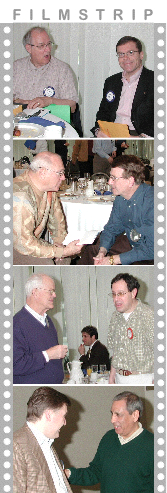

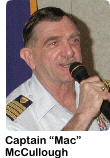 Captain Richard A. “Mac” McCullough, Commander of the U.S. Coast Guard cutter Polar Sea, described the fascinating story of duty in the ice-bound continent of Antarctica. Deep Freeze is an annual re-supply of vital fuel and foodstuffs to the National Science Foundation research site at McMurdo Sound.
Captain Richard A. “Mac” McCullough, Commander of the U.S. Coast Guard cutter Polar Sea, described the fascinating story of duty in the ice-bound continent of Antarctica. Deep Freeze is an annual re-supply of vital fuel and foodstuffs to the National Science Foundation research site at McMurdo Sound. Friday Potpourri
Friday Potpourri Cyril Faulkner, Director of International Service on the BBRC Board, conducted a quick lesson in the work of International Service.
Cyril Faulkner, Director of International Service on the BBRC Board, conducted a quick lesson in the work of International Service. International Service also sponsors our Youth Exchange project, which this year hosts Stefy Balitierra from Mexico. The program is a cooperative venture of the four Bellevue Rotary clubs. Mike Ralph is Chair of Youth Exchange.
International Service also sponsors our Youth Exchange project, which this year hosts Stefy Balitierra from Mexico. The program is a cooperative venture of the four Bellevue Rotary clubs. Mike Ralph is Chair of Youth Exchange. So far, WSC has given $850 for a polio-plus walk, $3000 to Chris Monger for medical equipment to Honduras, $1700 to the Prosthetic Outreach Foundation, and Curt will be leaving in a week for a school, water and sanitation project in rural Kenya.
So far, WSC has given $850 for a polio-plus walk, $3000 to Chris Monger for medical equipment to Honduras, $1700 to the Prosthetic Outreach Foundation, and Curt will be leaving in a week for a school, water and sanitation project in rural Kenya. Martinka’s trip was augmented by two $250 checks from Steve Szirmai and Bill Spencer which were matched by Microsoft, who provided 150 sets of software for the computers being installed in Slovakia. Despite the observation that “the Rotary Foundation is slow to pay,” Martinka received his matching funds recently, just in time for the team to head off on their trip. Two other projects: one to Jenny Andrews for $3000 to ship books to Ethiopia and one to Margie Burnett for a $2000 water project in Kampala, Uganda school.
Martinka’s trip was augmented by two $250 checks from Steve Szirmai and Bill Spencer which were matched by Microsoft, who provided 150 sets of software for the computers being installed in Slovakia. Despite the observation that “the Rotary Foundation is slow to pay,” Martinka received his matching funds recently, just in time for the team to head off on their trip. Two other projects: one to Jenny Andrews for $3000 to ship books to Ethiopia and one to Margie Burnett for a $2000 water project in Kampala, Uganda school.  The BBRC grew by one new member when William Corr Pearce III was inducted into the club Friday. Corr, as he prefers to be called, is sponsored by Jim Gordon. Wayne McCaulley is Corr’s co-sponsor, and Curt Cummings will get him going in his selected committee, World Community Service.
The BBRC grew by one new member when William Corr Pearce III was inducted into the club Friday. Corr, as he prefers to be called, is sponsored by Jim Gordon. Wayne McCaulley is Corr’s co-sponsor, and Curt Cummings will get him going in his selected committee, World Community Service.  Near the end of the BBRC’s annual Planning Retreat, President-elect-to-be Phil Salvatori sought recognition and told the assembled delegates that he had an announcement: “I regret to inform you all, but I have thought long and hard about the job I’m about to take on, and I must tell you ... I just can’t do it! Therefore, I’m resigning as your President for 2007.” A stunned silence followed as Phil retreated through the closed double-doors. About 30 seconds when by, then Sergeant At Arms Chris Ballard yelled, “Okay, Phil, your time’s up,” and the perpetrator showed up at another entrance to the large meeting room proclaiming “APRIL FOOL!” We knew it was coming but we couldn’t see it!
Near the end of the BBRC’s annual Planning Retreat, President-elect-to-be Phil Salvatori sought recognition and told the assembled delegates that he had an announcement: “I regret to inform you all, but I have thought long and hard about the job I’m about to take on, and I must tell you ... I just can’t do it! Therefore, I’m resigning as your President for 2007.” A stunned silence followed as Phil retreated through the closed double-doors. About 30 seconds when by, then Sergeant At Arms Chris Ballard yelled, “Okay, Phil, your time’s up,” and the perpetrator showed up at another entrance to the large meeting room proclaiming “APRIL FOOL!” We knew it was coming but we couldn’t see it! It was Jim Zidar’s Retreat, and his long years of corporate success showed. A smooth-running BBRC ship steered its way through a morning of thoughtful discussion, to produce a wall-full of ideas for the coming year. Zidar opened the 2006 Planning Retreat with 49 members present, commenting that Steve Lingenbrink’s year was “successful by any measure from the standpoint of the new fellowship activities that were established and an outstanding group of new, quality members joining the club. The involvement in 2005-2006 was good for the health of our club and retention of members. I appreciate being kept closely informed by Steve all through the year, and I promise to do the same for my successor, Phil Salvatori.” (Unless he resigns again on April Fool’s Day, 2007.)
It was Jim Zidar’s Retreat, and his long years of corporate success showed. A smooth-running BBRC ship steered its way through a morning of thoughtful discussion, to produce a wall-full of ideas for the coming year. Zidar opened the 2006 Planning Retreat with 49 members present, commenting that Steve Lingenbrink’s year was “successful by any measure from the standpoint of the new fellowship activities that were established and an outstanding group of new, quality members joining the club. The involvement in 2005-2006 was good for the health of our club and retention of members. I appreciate being kept closely informed by Steve all through the year, and I promise to do the same for my successor, Phil Salvatori.” (Unless he resigns again on April Fool’s Day, 2007.)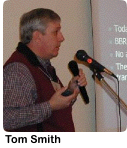 Prior to going into the three breakouts for the balance of the morning, Tom Smith, Club Service II Director, set forth to explain the club’s strategic plan for the days and weeks ahead.
Prior to going into the three breakouts for the balance of the morning, Tom Smith, Club Service II Director, set forth to explain the club’s strategic plan for the days and weeks ahead. Cary K explored the idea of having three separate fundraising events during the Rotary year. “The goal would be active participation by all members in two of the three events.
Cary K explored the idea of having three separate fundraising events during the Rotary year. “The goal would be active participation by all members in two of the three events.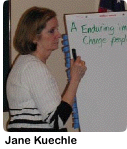 Jane Kuechle entertained a third of the attendees at a time, conducting three sessions concentrating on our giving habits.
Jane Kuechle entertained a third of the attendees at a time, conducting three sessions concentrating on our giving habits. Shelley Noble facilitated this breakout, building a list of things that proved to be favorites of the attendees. Some of the items included the newly-adopted school supplies project, the Hopelink book drive, the Giving Tree, Thanksgiving baskets, Rotary First Harvest, Preserve Planet Earth and Home Remodel projects for needy families.
Shelley Noble facilitated this breakout, building a list of things that proved to be favorites of the attendees. Some of the items included the newly-adopted school supplies project, the Hopelink book drive, the Giving Tree, Thanksgiving baskets, Rotary First Harvest, Preserve Planet Earth and Home Remodel projects for needy families.
 No one has ever accused the Bellevue Breakfast Rotary Club of attacking the target halfway. With great gusto and enthusiasm, teams of members spread out from Bellevue Friday morning and afternoon to participate in all kinds of interesting activities. There was the KopczynskiTeam of Cary K, Andrew F, Chip E and Steve V spending a good solid day on the slopes at Stevens. Then, there were the golfers — the Johnson Par Team of Norm Johnson, Cyril Faulkner, Tom Smith, and Rick Klobucher — slapping the ball around the East Wenatchee course. And finally, the Retail Therapy Team, unloaded carloads of money in their quest for hot buys. Competing for the top prize were Pat Smith, Carolyn Johnson, Sandy Zidar, Shelley Noble, Jane Kuechle and Jenny Andrews.
No one has ever accused the Bellevue Breakfast Rotary Club of attacking the target halfway. With great gusto and enthusiasm, teams of members spread out from Bellevue Friday morning and afternoon to participate in all kinds of interesting activities. There was the KopczynskiTeam of Cary K, Andrew F, Chip E and Steve V spending a good solid day on the slopes at Stevens. Then, there were the golfers — the Johnson Par Team of Norm Johnson, Cyril Faulkner, Tom Smith, and Rick Klobucher — slapping the ball around the East Wenatchee course. And finally, the Retail Therapy Team, unloaded carloads of money in their quest for hot buys. Competing for the top prize were Pat Smith, Carolyn Johnson, Sandy Zidar, Shelley Noble, Jane Kuechle and Jenny Andrews.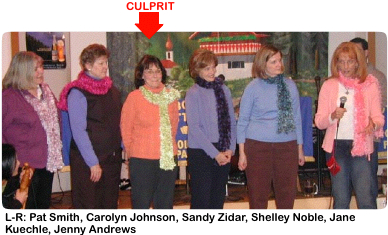
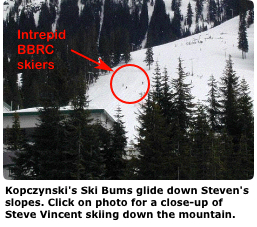
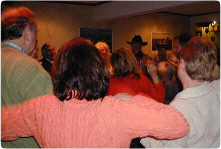 The remainder of the Ludwig portion of the evening was spent toe-tapping to the music of Bob Otto’s bunch. They were GOOD! Starting a concert with Beer Barrel Polka ensures success! Highlight of the music would be the famous Chicken Dance. A surprising number of Rotarians seemed to know this ancient rite.
The remainder of the Ludwig portion of the evening was spent toe-tapping to the music of Bob Otto’s bunch. They were GOOD! Starting a concert with Beer Barrel Polka ensures success! Highlight of the music would be the famous Chicken Dance. A surprising number of Rotarians seemed to know this ancient rite.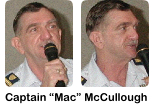 Captain Richard A. “Mac” McCullough, Commander of the U.S. Coast Guard cutter Polar Sea, described the fascinating story of duty in the ice-bound continent of Antarctica. Deep Freeze is an annual re-supply of vital fuel and foodstuffs to the National Science Foundation research site at McMurdo Sound.
Captain Richard A. “Mac” McCullough, Commander of the U.S. Coast Guard cutter Polar Sea, described the fascinating story of duty in the ice-bound continent of Antarctica. Deep Freeze is an annual re-supply of vital fuel and foodstuffs to the National Science Foundation research site at McMurdo Sound.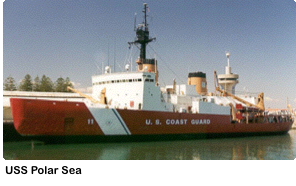 “This was the toughest trip in the history of this assignment. The 50th trip began in November of 2004, when the Polar Sea left Seattle. The crew had liberty in Honolulu and Sydney, Australia. Plying the southern seas is very challenging. There are few land masses to break up the ferocious waves and you encounter huge ice bergs on the way. The icebergs are beautiful, wind-carved objects, hundreds of feet high. Each one gets a number and is tracked by the Navy.”
“This was the toughest trip in the history of this assignment. The 50th trip began in November of 2004, when the Polar Sea left Seattle. The crew had liberty in Honolulu and Sydney, Australia. Plying the southern seas is very challenging. There are few land masses to break up the ferocious waves and you encounter huge ice bergs on the way. The icebergs are beautiful, wind-carved objects, hundreds of feet high. Each one gets a number and is tracked by the Navy.”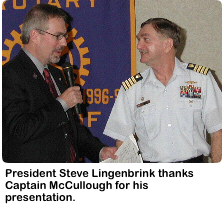 The Polar Sea has three pitch propellers, each 16 feet tall. Often they need maintenance. The Captain said that salt water freezes “just slightly below 28 degrees.” On this particular voyage, it became a joint project when the Russian icebreaker Krasin joined the effort to smash the heavy ice. On the way, the Polar Sea crew saw all kinds of wildlife, penguins, orcas, seals. On the way back from Antarctica, the crew offered humanitarian aid to residents of two islands in American Samoa who were buffeted by a strong cyclone.
The Polar Sea has three pitch propellers, each 16 feet tall. Often they need maintenance. The Captain said that salt water freezes “just slightly below 28 degrees.” On this particular voyage, it became a joint project when the Russian icebreaker Krasin joined the effort to smash the heavy ice. On the way, the Polar Sea crew saw all kinds of wildlife, penguins, orcas, seals. On the way back from Antarctica, the crew offered humanitarian aid to residents of two islands in American Samoa who were buffeted by a strong cyclone.